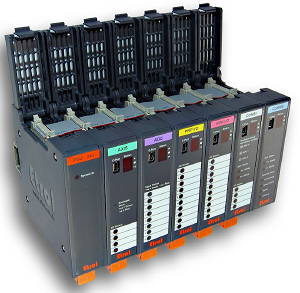Node-based control system uses one language for all functions
A British company has developed a modular control system consisting of a series of nodes dedicated to specific functions such as motion control, communications, and digital and analogue I/O. There is also a compatible colour touchscreen HMI. Each DIN-rail-mounting node is programmed independently and all use the same programming language and a single development environment, avoiding the need to learn different languages for different functions.

The E-Node system, which is aimed at small- to medium-sized industrial machines and process control systems, has been developed by Etrol, based in West Sussex. At the heart of each node is a 32-bit, high-speed, single-chip microcontroller with embedded memory, and support for CAN and Ethernet communications. Peripheral technology is added to the microcontroller to create the specific functions for each node.
A central element of the E-Node system is a dedicated high-reliability network called E-Net that runs on a mix of two physical media: CAN for short links between nodes; and Ethernet for longer distances. Every node has embedded E-Net access. To ensure reliability and deterministic communications, E-Net uses dedicated low-level communications protocols, so the CAN and Ethernet links cannot form part of another network.
The various nodes share facilities over the network. Adding a node adds programming power and storage memory. A network can consist of up to 1,000 nodes, which can be added or removed easily.
The structured programming language, called Control-C, is a simplified version of the standard C language, enhanced to support the various module functions. There is no need to learn separate languages for PLC and motion control functions, and software modules can be re-used.
Etrol began life in 1999 as Netmotor, which focussed on bespoke industrial control electronics and intelligent motors. Its activities later broadened into the general control of industrial processes, with an emphasis on high-performance, special-purpose machines. In 2005, the company was renamed Etrol to reflect its new direction.





